Have you heard of the Saronic Gulf island of Agistri?
If you’re not Greek, you’ve probably never heard of Agistri island. As Greek islands go, the Cyclades islands hog all the attention – stylish destinations like Santorini and Mykonos – as well as the Ionian islands, especially Corfu, and the largest island, Crete.
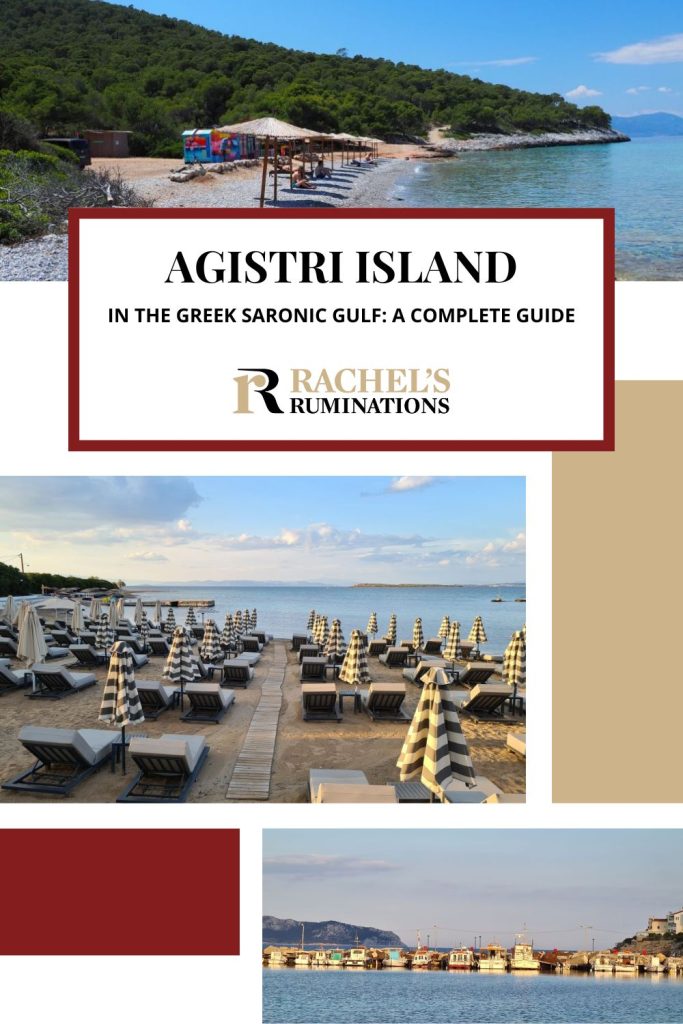
Yet I can’t really call Agistri Island “off the beaten path,” or – as many travel bloggers might call it – a “hidden gem.” It’s apparently enormously popular for a day trip or as a weekend or summer vacation destination for Greeks. I visited in May and it wasn’t very crowded, but I was assured by a number of different people while I was there that it gets busy in the summer months or during other Greek school vacations.
Disclosure: I ended up spending a few days on Agistri because I was offered a sponsored stay at Oasis Beach Hotel in the village of Skala. Nevertheless, the hotel has no influence over what I write. In any case, it doesn’t seem to need any promotion; even in May it was full, so they put me in Agistri Apartments, which they also operate, nearby. When I asked Panos, my contact at the hotel, why they were sponsoring me, he explained that he wanted me to write about the island, not the hotel, and, as he talked to me about Agistri, his pride and love for “his” island just shone.
And another disclosure: This article contains affiliate links. If you click on one and make a purchase, I will receive a small commission. This will not affect your price.
So why is the island of Agistri so popular? Because it’s lovely! It’s just a small island (14 sq km or 5.5 sq mi), with only three villages of any size. The rest of the island is covered in pine forest, which means it’s an ideal destination if you want to combine some wonderful hiking up to beautiful views with cooling off on picturesque beaches.
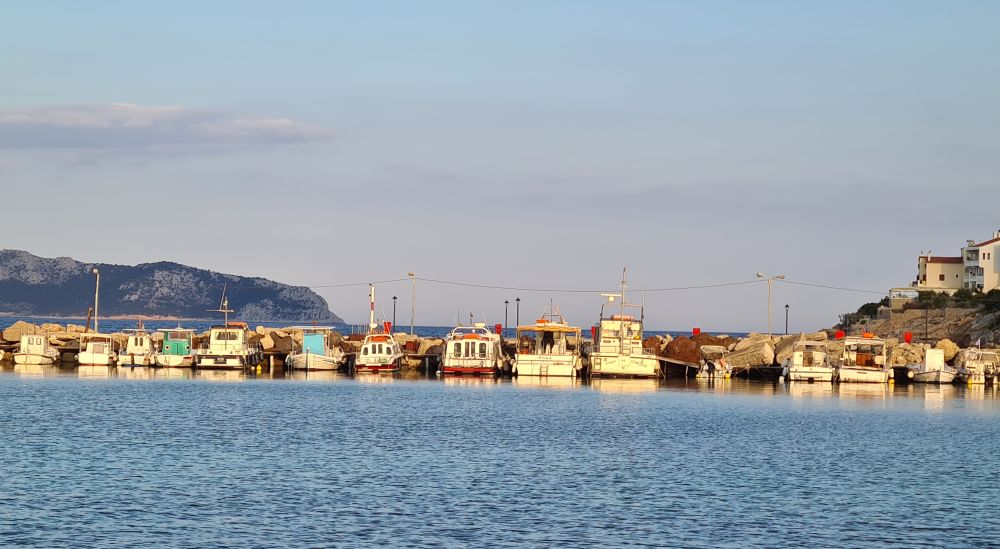
Agistri is in the Saronic Gulf, part of the Saronic islands, sometimes called the Argo-Saronic islands. The Saronic Gulf is the body of water between the peninsula where Athens is and the Peloponnese to its west. The Saronic Gulf island you’re most likely to have heard of is Aegina, but Agistri is close by Aegina.
Of course, its location contributes to its popularity with Greeks: it’s near Athens. From the port of Piraeus, the ferry ride takes under an hour on the high-speed ferry and about an hour and a half on the regular ferry.
Agistri’s other claim to fame, according to Panos, is that it’s the greenest of all the Greek Islands. I haven’t been to every Greek island, but I’ve been to at least ten, and I think he may be right. Pine forests cover most of the island, though here and there they’ve been replaced by olive groves.
Agistri’s three main villages
Only two kilometers apart, Skala and Megalochori (also called Milos) are the two towns that cater most to tourists on the island. Megalochori is the island’s capital. It’s older and more traditional than Skala, which makes it distinctly more charming to me, especially away from the shorefront tourism-oriented businesses. I loved the stone-built houses in this sleepy older part of town, some of them whitewashed.
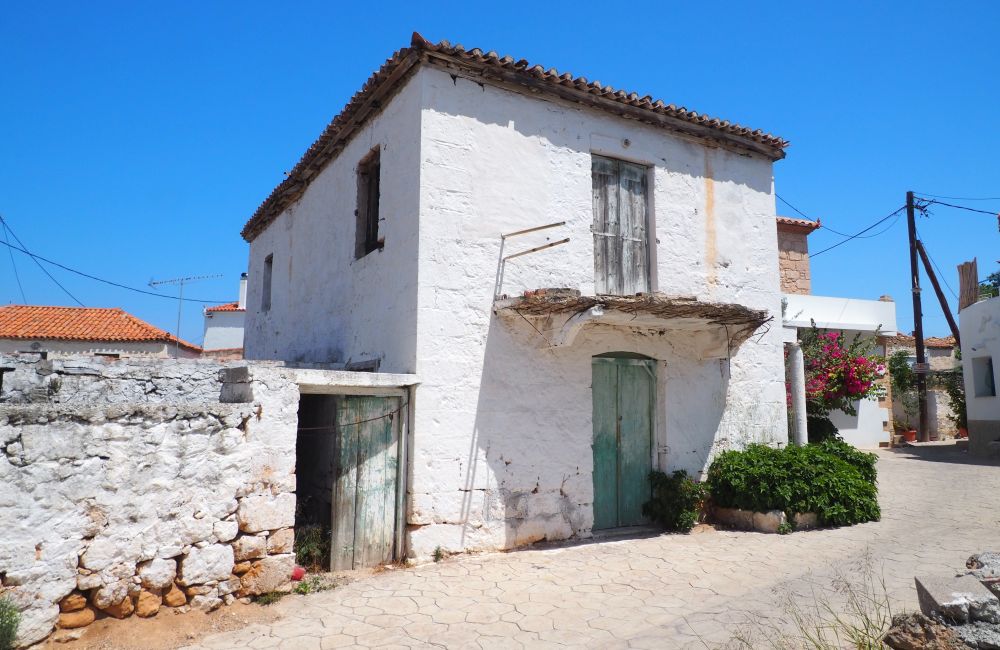
Neither town is especially pretty, I’d say, at least not in comparison to places like Santorini or Naxos. What’s pretty is the countryside: the hills covered with pine forest and the views from the peaks. The buildings in Skala are mostly white-painted concrete and fairly recent. Yet Skala has a beach resort kind of charm that I find welcoming and relaxing.
The “settlements” of Metochi and Skliri are neighborhoods adjacent to and part of Skala. Metochi is uphill is the oldest part of Skala, and Skliri is the area on the south side of Skala along the coast.
The third town is Limenaria. It’s a tiny place, not much more than a cluster of houses nestled between hills, on the other side of the island and not right on the shore. You’ll pass through it if you go to Aponisos Beach.
Agistri’s beaches
As an island, Agistri is, of course, ringed with shoreline, and that shoreline has lots of beaches. Three of them are most well-known: Skala Beach, Dragonera Beach and Aponisos Beach. There are other beaches – perhaps undefined or without names or only appearing at low tide – so if you want to get away from people, go look for other bits of sand in the little coves all around the island.
Skala Beach
Skala Beach is, as the name implies, in Skala town. It’s sandy and calm with unbelievably crystal clear waters. The part right next to the town – including the section in front of Oasis Hotel – is mostly claimed by hotels, and much of it is covered in rows of beach chairs and umbrellas.
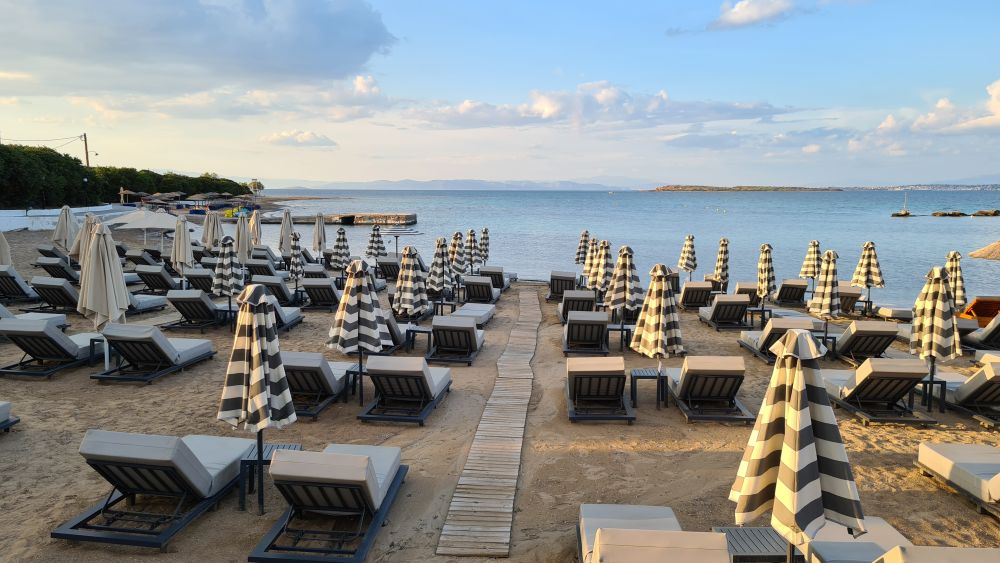
But the beach extends further. Walk away from the Oasis along the beach toward the point (to the left as seen in the photo above). At the point and past it to the left, you’ll find plenty of undeveloped beach. So if you don’t want to pay for a beach chair and umbrella, you don’t have to. Any part of this beach is a great place to watch the sunset.
Tip: Visit three islands – Agistri, Moni, and Aegina in one day trip on a Greek sailing ship! Enjoy swimming and snorkeling on picturesque beaches.
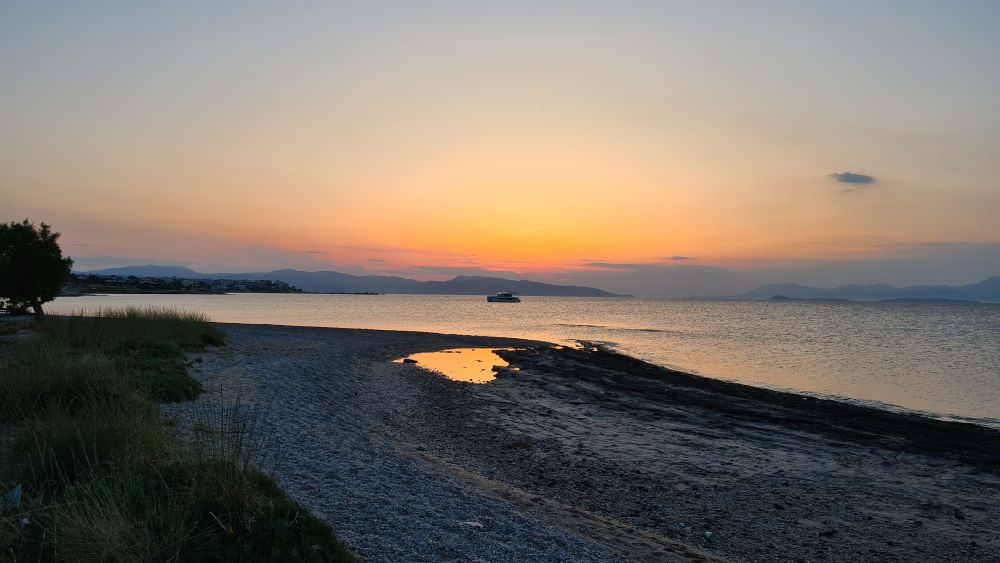
Dragonera Beach
Dragonera Beach is further away, in the middle of the west coast of the island. This pebbly beach is more rustic and less developed. When I was there in May there was a single row of thatched umbrellas and a small kiosk. Apparently in the high season you can rent a lounge chair and some water sports are available too. To get to Dragonera you’ll either need to hike the distance, take a taxi, or rent a car, bike or scooter. It’s about three kilometers from Megalochori and four kilometers from Skala. If you choose to hike, just keep in mind that the island is hilly. You’ll need to walk on the road because there do not seem to be any trails that go to Dragonera.
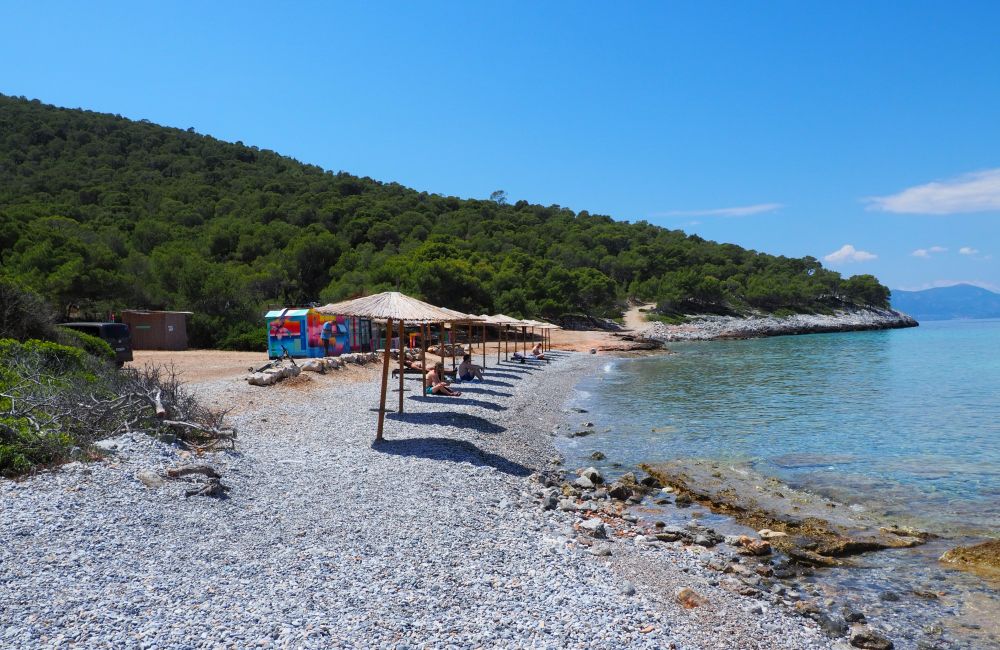
Aponisos Beach
Aponisos Beach isn’t really a beach, in my view. Rather, it’s a rocky little island, connected to Agistri via a pier and a short bridge. Rather than wading across a sandy or pebbly beach to go in the water, you climb or jump down off of rocks. Nevertheless, it’s a popular place. It’s privately-owned, with a five-euro admission charge, which includes use of an umbrella and chair. You can rent a canoe or watch for the island’s resident goats, parrots and peacocks. There’s also a snack bar on the little island.
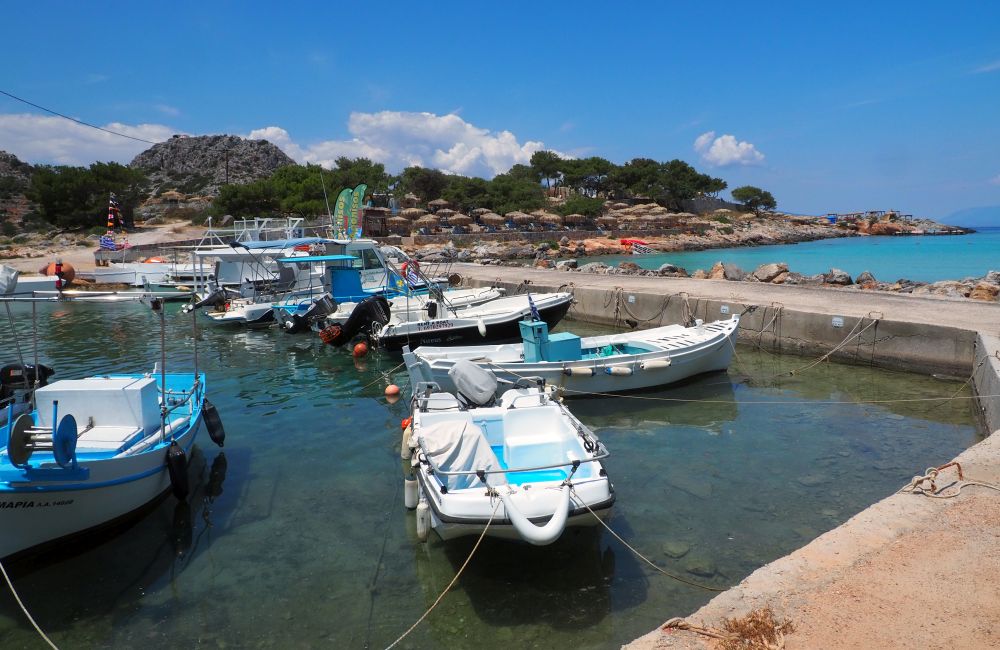
Other Agistri beaches
Two other beaches I didn’t visit seem to be quite popular: Skliri Beach and Chalikiada Beach. Neither can be reached by any wheeled vehicle and both are undeveloped, with no services at all.
- Skliri Beach is nearest to Skala Port, which means it is popular, getting very crowded in the summer months. It’s a small, pebbly beach tucked in a cove and reached via a steep staircase from the hill above.
- Chalikiada Beach is further south and harder to reach, so it’s less crowded. Like Skliri Beach, it apparently involves a scramble downhill to reach it. It is known as a nudist beach – its inaccessibility means families don’t tend to come here. It’s partly sandy, partly pebbly, and it’s often also used as a free place to camp.
Historical and cultural sights on Agistri
There aren’t any. Or rather, there are a few interesting churches, but that’s about it. Agistri has as long a history as any other part of Greece, but it’s always been a bit of a backwater, only noticed when wars broke out with the Arabs and the Byzantines, at which point ancient structures got destroyed. A few current buildings sit on ancient foundations, like the Church of Agia Kyriaki in Limenara. The church you see today dates from the 16th century, but a church existed on the site a thousand or so years earlier.
The church you’ll spot first as you arrive on Agistri island is Agioi Anargyroi in Skala, with its blue dome. I can’t seem to find a date for it, but I suspect it’s newish, built in the 20th century.
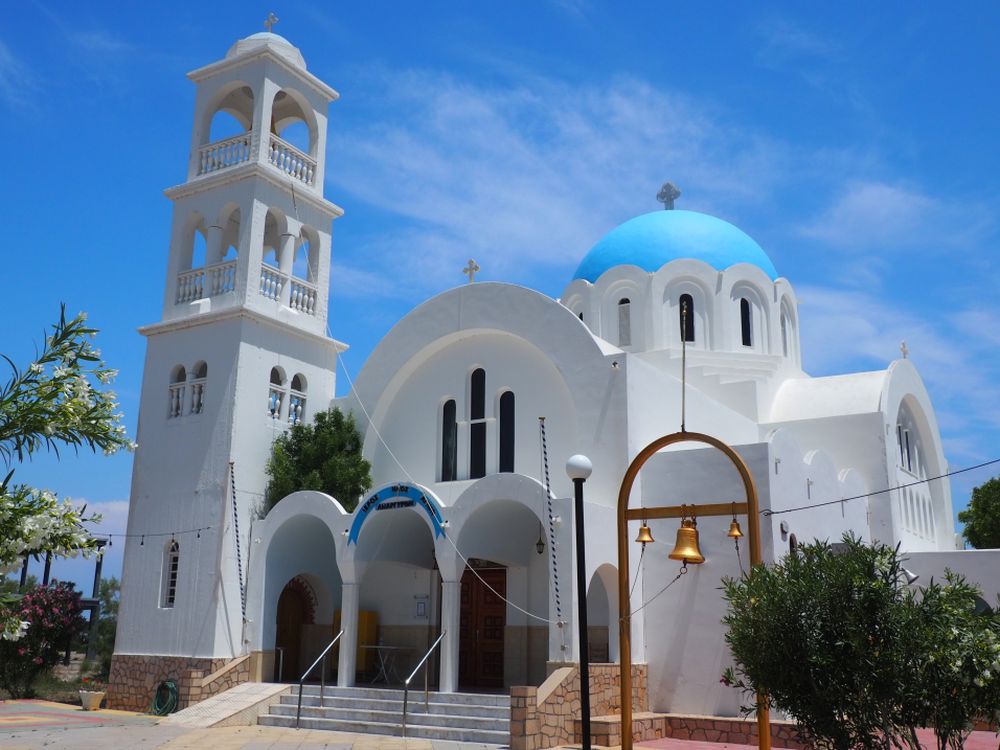
In Megalochori there are two more churches worth a quick stop. The Chapel of Agios Georgios (18th century) has Maltese tiles on the floor. Quite nearby, the unpainted stone church of Zoodochos Pigi has a domed basilica and dates from 1885. I didn’t see them, but apparently it has some wonderful frescoes inside.
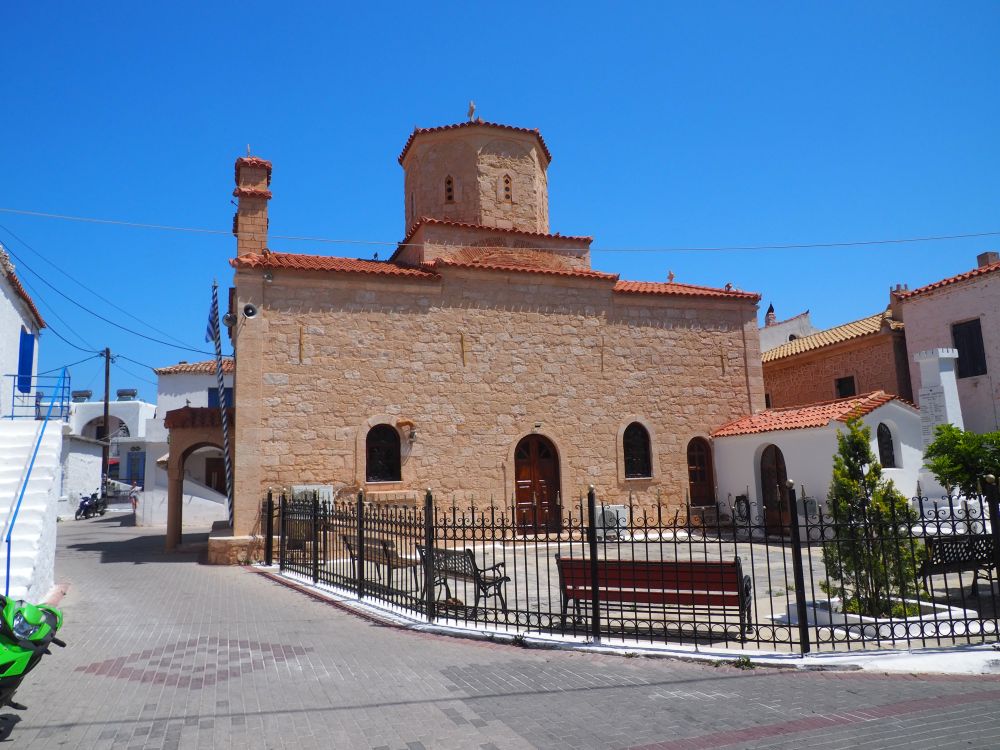
I enjoyed stopping at the Church of Panagia in Metochi, up the hill above Skala, not so much for the church, which is small and simple, but for the huge view over Skala and over the sea to other nearby islands.
If what you’re after is historical sites, you’d be better off visiting Aegina, but I’ll get to that later in the section “Aegina or Agistri.”
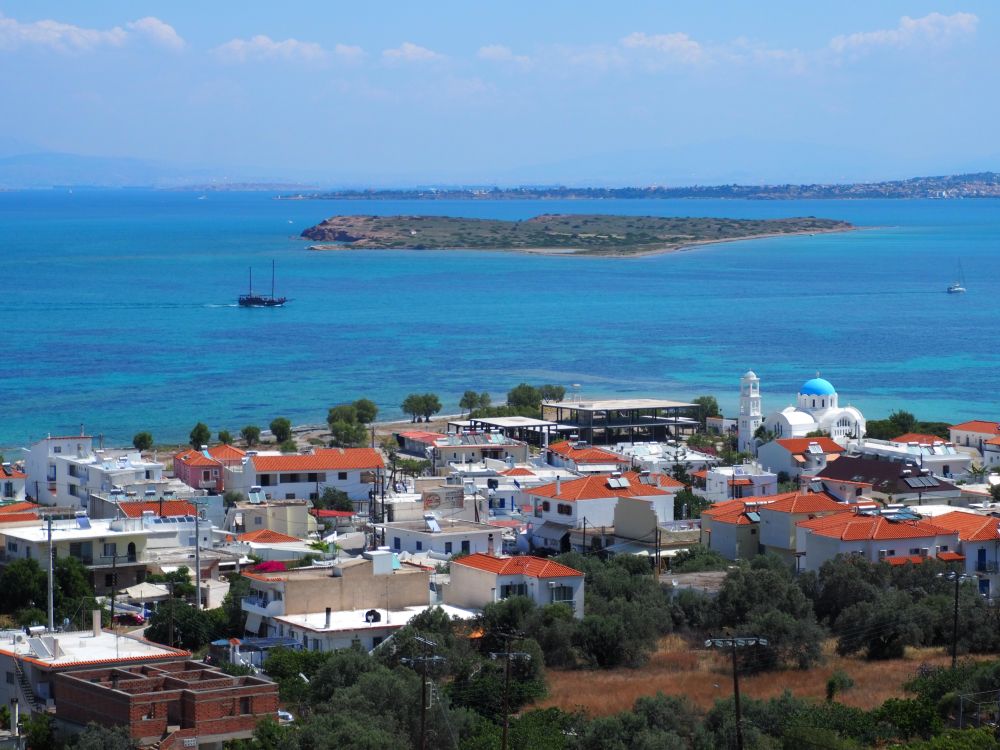
Things to do on Agistri
Given Agistri’s beautiful beaches, if sunbathing and swimming are your things, you’re all set. The water is blue and clear and at the beach in Skala it has a sandy floor and very calm water, so it would work well with kids. I met a Dutch woman at the Oasis Hotel bar who told me she’d been coming to the Oasis for 20 years. For many years it was her family vacation with her kids; now she still goes there once or twice a year on her own.
Anyway, Agistri is also worth visiting if you like to do any of these activities:
Hiking
I’ve already mentioned that Agistri is great for hiking. There are a number of designated hiking trails, and the small size of the island means it would take just a few days’ hikes to pretty much see it all. I didn’t do this – Panos took me on a tour by car since my time was limited, but I could see the potential for pleasant walks in the shade of the pine trees up to gorgeous views from Agistri’s hills and down to tiny cove-enclosed beaches.
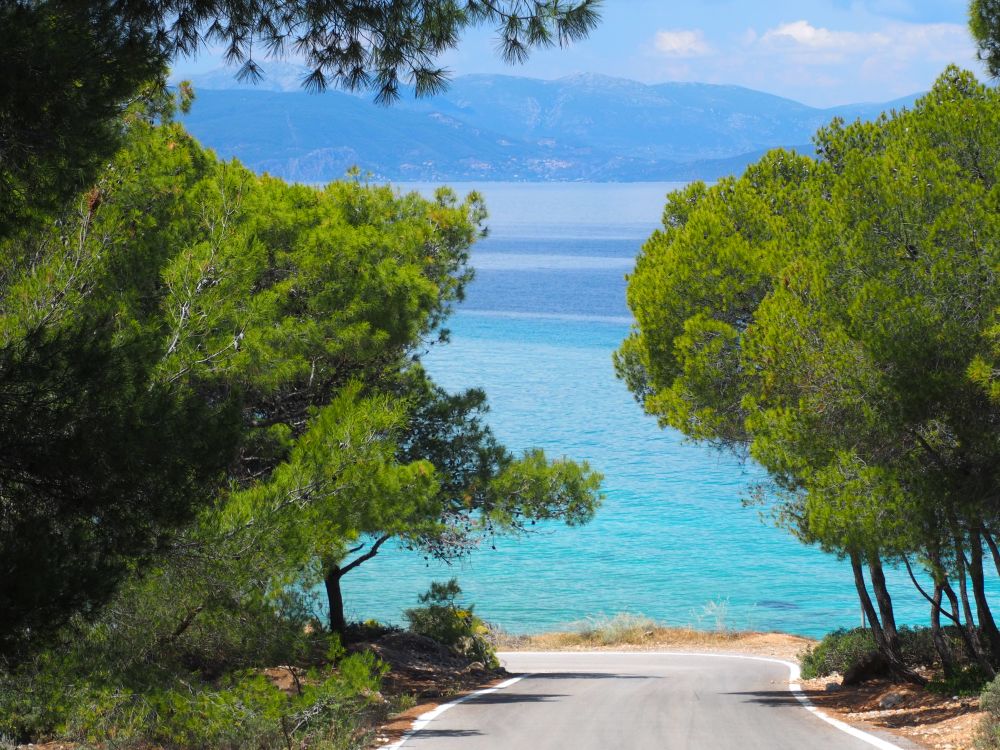
Exploring on wheels
You could also rent a bicycle, e-bike or scooter – I saw several rental places in Skala. Bicycling the hills would be tough unless this is something you do often, but you’d be rewarded by the downhill glide afterwards, and a dip in the ocean when you’re done.
Bird watching
While there are birds to see everywhere, the highlight is in the winter months, when flamingos come to Agistri Lake (also called Lekani Lake), a small brackish-water lake near the village of Limenaria.
Horse riding
On the shore of little Agistri Lake is Aponisos Stables, where you can hire a horse for a ride in the woods or take riding lessons.
Eating
There are two main harbors on Agistri: at Megalochori and at Skala. Both are quite small and most of the boats I saw there were fishing boats rather than pleasure boats. That means that if you like fresh fish, Agistri is the place to be! I had some delicious food while I was on the island, particularly a simple whole grilled fish that was clearly fresh and wonderfully tasty. And of course you can find all of the usual classic Greek dishes like souvlaki or Greek salad at any of the charming-looking Greek tavernas.

Water sports
If you prefer water sports, you can rent a kayak or paddleboard, and snorkeling is an option as well. You won’t see corals, but you’ll see fish and you’ll see them clearly because of how clear the water is here.
Boating
Another way to enjoy the water would be to take a boat tour. These can take you to little coves on Agistri, or to one of the nearby smaller islands, particularly Metopi Island and Kira Island:
- Metopi Island: Located halfway between Agistri and Aegina, Metopi Island has no residents; it’s flat and bare, home only to a small chapel and some vineyards. (You can see it in the photo above of the view from the Church of Panagia.) It doesn’t even have any trees. I haven’t been there, but apparently there’s a pretty white-sand beach on the southeastern side of the island. There are no roads or services, and getting there requires hiring a private boat. The story goes that the island has many owners, mostly Agistri residents who inherited their part. This is why, despite its prime location, it’s never been developed for tourism – they’d have to all agree on the deal.
- Kira Island is on the other side of Agistri, closer to the Pelopponese. Despite the fact that it’s hillier and has some trees growing on it, it’s also uninhabited. Like Metopi, it has no roads or services, but does have some small sandy beaches in some of its coves. Like Metopi, you can only get there by hiring a boat.
This all-day sailing cruise from Athens includes stops at both Aegina and Agistri (Megalochori). So does this sailing cruise.
Touring the island
Another option if you want to see the highlights in half a day, as I did, is to hire Panos, or rather his company, called Greece Private Transfer. He’ll take you all over the island to see whatever parts interest you. You can book him here. He also, as the company’s name implies, can arrange transfers to or from Piraeus Port or Athens Airport. Boat trips around Agistri or one of several other boat tours are also something he’ll arrange for you.
Aegina or Agistri?
You may be trying to decide which of the Saronic Gulf islands you should visit. The short answer, I’d say, is “both.” They’re very different, in other words, so you’d want to choose by what activities you like to do. And it’s easy enough to hop between the two islands – it takes about 10-20 minutes and the ferries run back and forth several times a day. I spent a day on Aegina island this trip, and I’d also been there before. Here’s a bit of a comparison:
- If all you’re after is days on the beach, drinks at beach bars every evening, good food in traditional tavernas, and green surroundings, I’d suggest that Agistri is the best place for you.
- If you’re looking for a kid-friendly beach destination with crystal-clear waters that’s not overstimulating for your kids, again I’d say that Agistri is a great place to go.
- On the other hand, if you’re like me and really enjoy historical sites, Aegina is better. While both islands have a rich history, Aegina’s has survived much better. Its main historical landmarks are the archaeological sites of the Temple of Aphaia (490 BC) and Paleochora – a ruined town where more than a dozen ancient churches still stand – as well as more recent historical sites like Nectaria monastery.
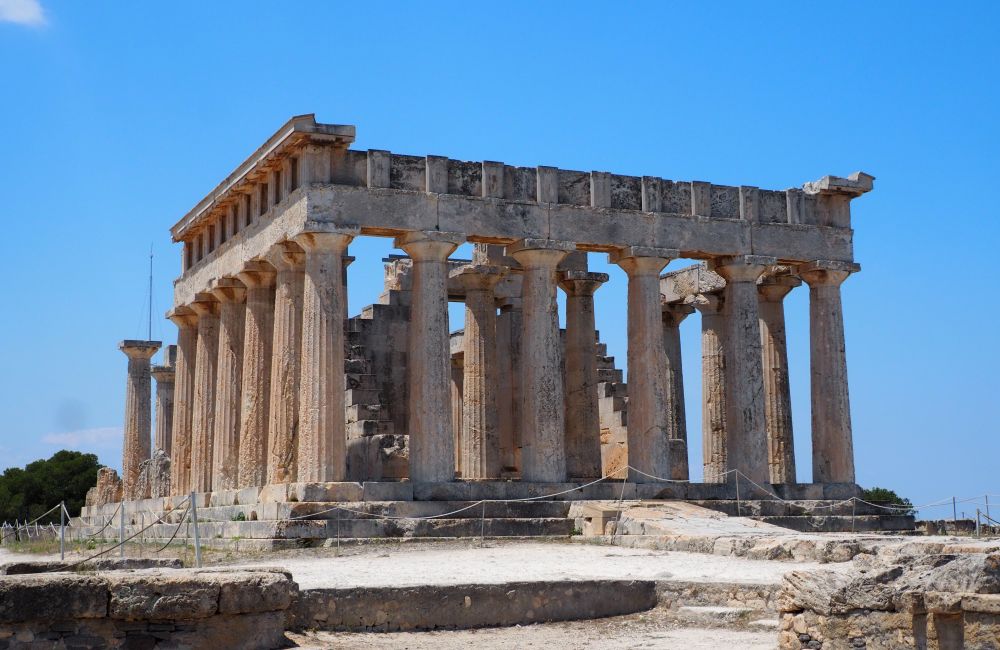
- Aegina is bigger, with good souvenir shops and plenty of tourist amenities. In other words, it’s less laid-back than Agistri. After a couple of days on Agistri, disembarking in the main town, also called Aegina, felt like arriving in the big city. It has a different character somehow.
- Both islands offer excellent food and pretty scenery, though Aegina is less green than Agistri.
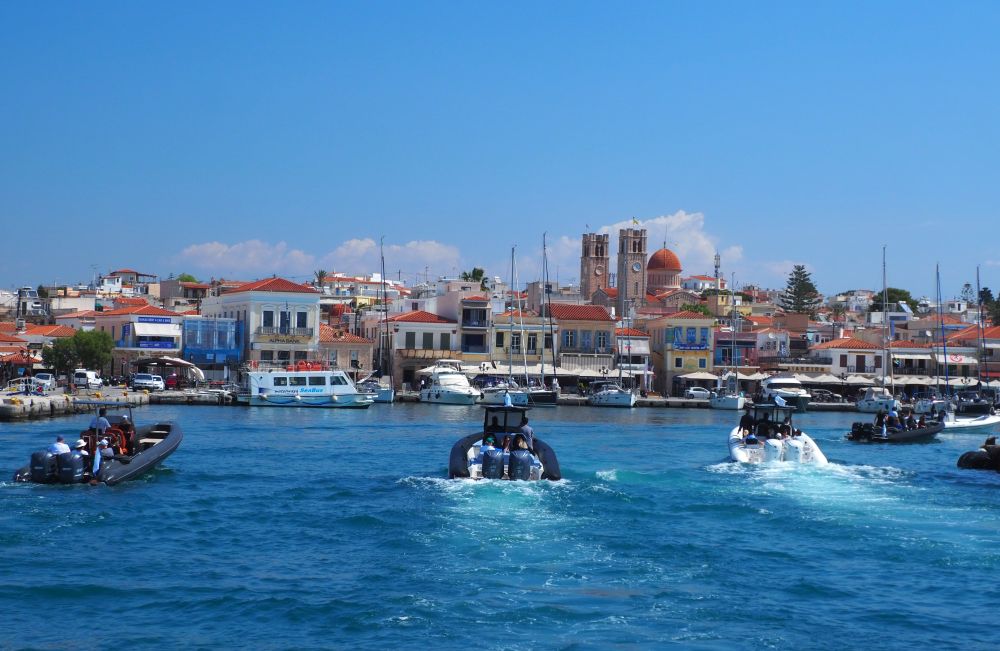
Getting to Agistri
Getting to Agistri, like most Greek islands, is more complicated than it should be. That’s because a number of different companies offer the route from Piraeus to Agistri, and each one has its own ticket sales from different ticket booths or different websites. They don’t accept each other’s tickets either. And they don’t all go to the same place – some go to Megalochori, while some go to Skala. That means you need to do your research.
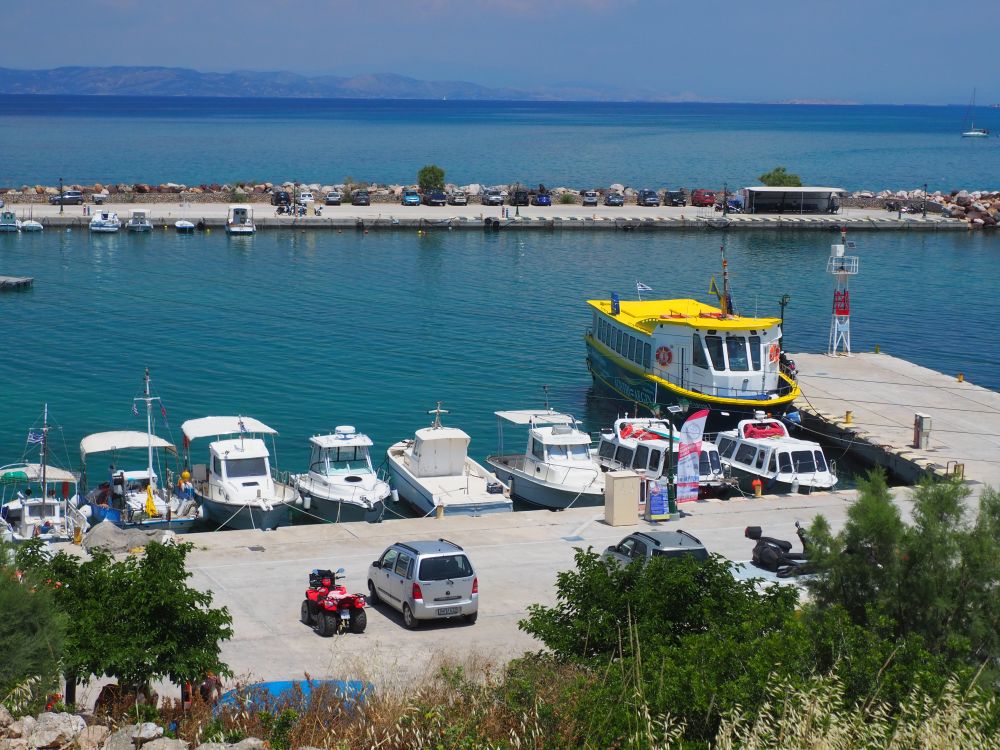
I didn’t. On Aegina I wanted to buy tickets back to Agistri. The ticket booths for all the ferry companies were in a row in the harbor and I had to wait in line at each one to ask about ferry times and to finally decide and buy my ferry tickets. I neglected to ask where on Agistri they went, and ended up in Megalochori rather than Skala. Fortunately it wasn’t very hot out and I enjoyed the quiet walk along the seafront back to Skala, but I suspect the couple walking ahead of me, both arriving with very large backpacks, were not happy.
After the fact, I found the Ferryhopper site, through which you can check schedules and book your trip. Use the form below:
Once you’re on the island and you need to leave again, it’s easier – staff at your hotel will likely know the schedules and be able to help you get a ticket. Or, again, you can use the form above.
- The “Flying Dolphin” is operated by Aegean and gets to Agistri in 55 minutes. Going this fast costs more than the normal ferries, and these boats have no outdoor seating. Some go to Skala; some to Megalochori.
- Blue Star Ferry operates a fast ferry called “Aero,” which also costs more than a normal ferry and takes 55 minutes. These seem to mostly go to Megalochori, but ask when you buy your ticket, just to be sure.
- Saronic Ferries operates the normal ferry line, which costs a bit less and takes 1 hour 35 minutes. It lands at Skala.
The same warnings apply for travel between Agistri and Aegina: the ticket situation is confusing. The fast boats take 10 minutes; the regular ferries 20 minutes.
You might also enjoy these other articles about travel in Greece:
Where to stay on Agistri
The only hotel I can vouch for is the one that sponsored me, Oasis Beach Hotel, a family-run hotel that is applying for 4-star status. I stayed at Agistri Apartments away from the beach, but I did get to eat at the hotel and toured a room before new guests arrived. The room was gorgeous, all done in cool white with simple accents, and it had a wonderful view over the beach and across the water to Aegina. The apartment I stayed in was spotlessly clean and extremely roomy, but without the view and a bit older, so less impressive than the hotel.
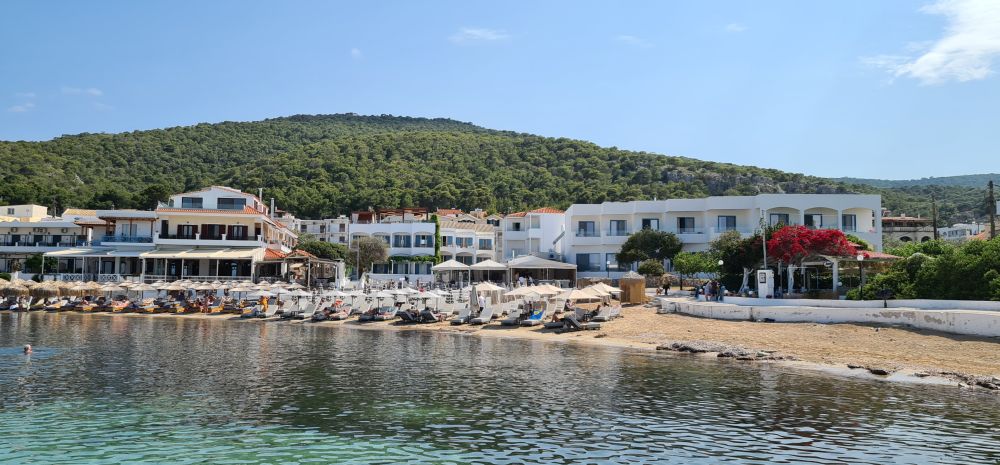
The food at the hotel – served at tables outside next to the beach – was really excellent: as I mentioned, the grilled fish was delicious, and so was the salmon salad I had one evening. The hotel has a small pool – though I must say I’ve never quite understood the point of having a pool right next to a beach – and a very pleasant outdoor bar.

There are other hotels, of course, on the island, most of them in or near Skala or Megalochori. Take a look at the map below to see what’s available and to book your accommodation. If you’re planning a summer visit, book far in advance!
When to visit Agistri
I was there in May and found the water a bit too cold to swim, but some people were sunbathing and swimming. It wasn’t at all crowded anywhere I went on Agistri. People I met at the Oasis Hotel bar told me that it gets crowded in the summer months and right through to when the Greek schools reopen in mid-September. I think the best times to be there are probably mid-May to mid-June and mid-September to mid-October.
If hiking is your thing, though, you’d certainly still enjoy it earlier in the spring and later in the fall. In the summer it might be too warm. On the other hand, even at the height of summer you can entirely escape the crowds on a hike into the hills.
Keep in mind that, off-season, some restaurants might be closed.
Tips for your visit to Agistri
- Particularly in the summer, it’s important to book your accommodations well in advance because hotels book up.
- Carry a water bottle with you everywhere. The tap water is safe, and bottled water is available.
- Wear a hat and sunglasses.
- Put on sun lotion several times a day and after every swim. Even in May, I put on SPF 50 lotion once every day. I didn’t spend any time sitting on a beach, yet I still got quite tanned. That was not my intention; I should have kept applying it.
- Wait till it’s late and the air cools a bit before eating dinner. That’s what the Greeks do, and it makes sitting at an outdoor table much more comfortable. And you can watch the sunset at the same time.
- If you’ve chosen Agistri as your base, at least take a day trip to Aegina to see the Temple of Aphaia and to walk around the atmospheric Paleochora.
FAQs
Where is Agistri Island?
Agistri is in the Saronic Gulf between Athens and the Pelopponese. It is west of its sister island, Aegina.
Is Agistri Island worth visiting?
If what you’re looking for is a quiet place with good beaches, pretty scenery, great food, and perhaps some forests to hike in, then Agistri is definitely worth visiting. If you’re looking for Greek historical sites, it’s not the best location in Greece to visit.
Should I visit Agistri or Aegina?
Aegina is bigger and busier, but also has more historical and cultural sites to see: an ancient Greek temple, a monastery, and many medieval churches. Agistri is better for a quiet beach-oriented vacation or for hiking in pine forests.
How far is Agistri from Athens?
By ferry it’s either 55 minutes or 1 hour and 35 minutes.
Is Agistri worth a day trip from Athens?
Yes, it’s an easy day trip for a quiet day at the beach or for a pleasant hike in the woods.
My travel recommendations
Planning travel
- Skyscanner is where I always start my flight searches.
- Booking.com is the company I use most for finding accommodations. If you prefer, Expedia offers more or less the same.
- Discover Cars offers an easy way to compare prices from all of the major car-rental companies in one place.
- Use Viator or GetYourGuide to find walking tours, day tours, airport pickups, city cards, tickets and whatever else you need at your destination.
- Bookmundi is great when you’re looking for a longer tour of a few days to a few weeks, private or with a group, pretty much anywhere in the world. Lots of different tour companies list their tours here, so you can comparison shop.
- GetTransfer is the place to book your airport-to-hotel transfers (and vice-versa). It’s so reassuring to have this all set up and paid for ahead of time, rather than having to make decisions after a long, tiring flight!
- Buy a GoCity Pass when you’re planning to do a lot of sightseeing on a city trip. It can save you a lot on admissions to museums and other attractions in big cities like New York and Amsterdam.
Other travel-related items
- It’s really awkward to have to rely on WIFI when you travel overseas. I’ve tried several e-sim cards, and GigSky’s e-sim was the one that was easiest to activate and use. You buy it through their app and activate it when you need it. Use the code RACHEL10 to get a 10% discount!
- Another option I just recently tried for the first time is a portable wifi modem by WifiCandy. It supports up to 8 devices and you just carry it along in your pocket or bag! If you’re traveling with a family or group, it might end up cheaper to use than an e-sim. Use the code RACHELSRUMINATIONS for a 10% discount.
- I’m a fan of SCOTTeVEST’s jackets and vests because when I wear one, I don’t have to carry a handbag. I feel like all my stuff is safer when I travel because it’s in inside pockets close to my body.
- I use ExpressVPN on my phone and laptop when I travel. It keeps me safe from hackers when I use public or hotel wifi.





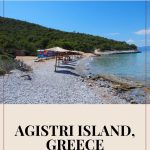


I’m so happy I found this article! My husband and I will be spending 3 days in Agistri at the Oasis during August, prior to meeting friends and going on a Viking cruise. I’m hoping when I figure out the ferry system that we will be able to take a day trip or two to neighboring islands. Thank you – very comprehensive. Strange question – do restaurants have selections other than seafood?
Yes, of course! They have all the traditional Greek dishes like moussaka and grilled meats of various kinds. And you can always find pizza and other Italian food too.
Thanks for all this info. We will be going with our10 year old and 6 year old and this will be helpful!
Enjoy! It would be a great place for a relaxed family vacation, and the water is very calm.
Do you think we will find enough to do for a week in Agistri? Or is that stay too long?
It depends what you want to do. If you like to do lots of sightseeing, it’ll be too long, I think. If you like to hike in the woods, spend time at the beach and enjoy Greek food, it’s a great place to spend a relaxing week.